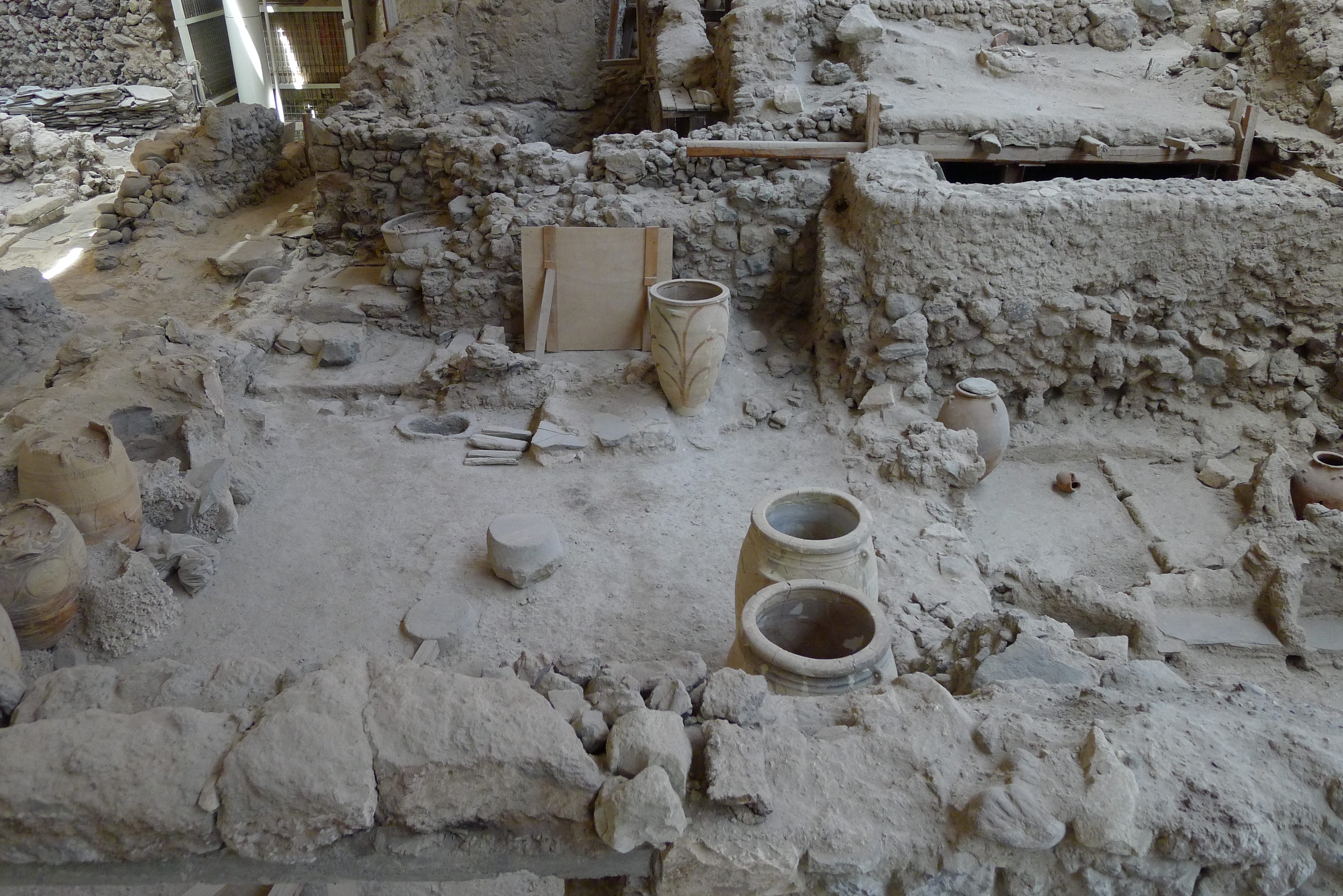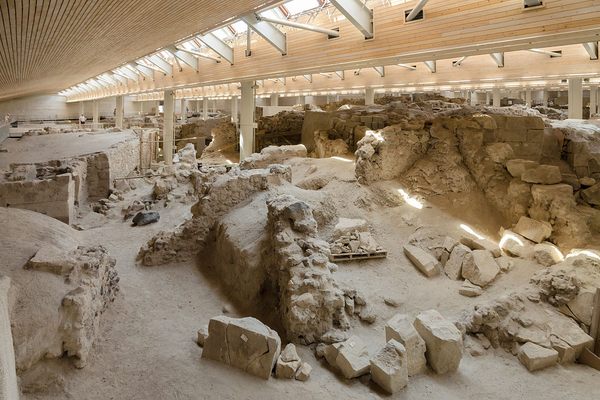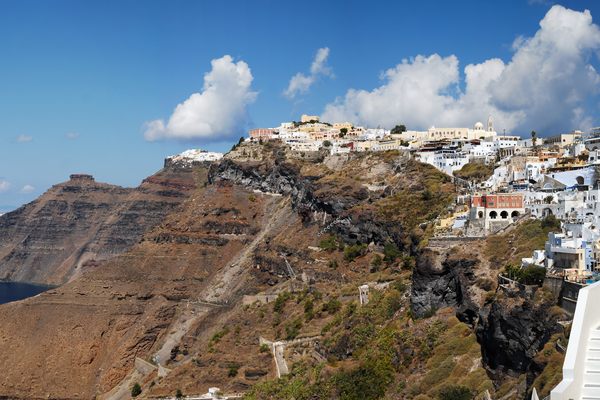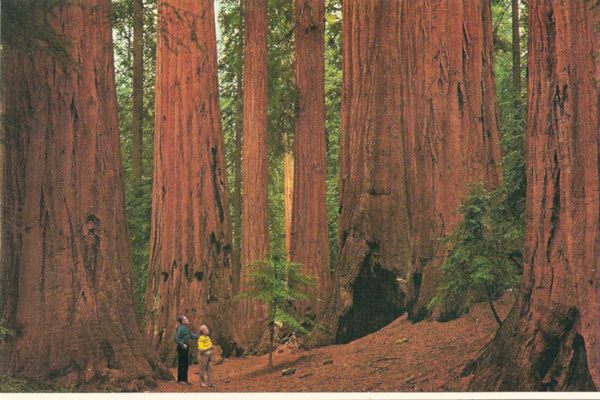No One Knows the Exact Year of the Largest Volcanic Eruption of Our Age
Scientists are hoping archaeology, carbon dating, and tree rings together can help solve the mystery.

They left before the eruption came, abandoning their island, their frescoes, their furniture. When the volcano blew, sending ash more than 18 miles up, into the stratosphere, it blanketed the the island and darkened the sky. Across the Mediterranean, people saw the effects of the eruption at Thera, which was so large it changed the climate for a time. It was larger than Vesuvius, or Tambora, or Krakatoa. It’s thought to be the largest volcanic eruption ever witnessed by humankind, or the largest volcanic eruption in the current geological era, which goes back almost 12,000 years.
This catastrophic event, which spelled the end of Bronze Age Minoan civilization, may have cast a shadow over Mediterranean tales and myths for ages. It is thought that the eruption could be the origin of the myth of Atlantis, a lost island world, or the source for the Biblical plagues of Egypt—polluted river, darkened sky.
But over thousands of years, details and dates have a way of blurring, so that now no one knows exactly when the eruption took place. It was almost certainly more than 3,500 years ago. Evidence in texts from Egypt’s New Kingdom suggests the 16th century B.C. Radiocarbon dating of materials found from Thera (known today as Santorini), though, put the date a little further back, in 17th century B.C.
For years, experts have struggled to reconcile this gap and pin down the exact date of the eruption. The ash that spewed from the volcano settled across the Mediterranean and the layer can still be found in the ground. If the event could be precisely dated, that layer would provide a very useful time horizon for understanding chronology across the region. In a new paper published in Science Advances, a team led by scientists at the University of Arizona has gathered new data that they think could help resolve the mystery.

The problem of the Thera eruption gets at one of most basic questions of archaeology: How do we know when things happened in the past? In the absence of written records that can be lined up with known calendar systems, pinning down the specific year of an event can be tricky, if not impossible.
But archaeologists have a few strategies. The growth rings of trees, for instance, keep a record that can be traced back thousands of years by matching up rings of trees whose lives overlapped. Some long-lived species, such as bristlecone pine, can contain records going back thousands of years on their own. Radiocarbon dating is another critical, widely used tool. It measures the amount of a radioactive carbon isotope, carbon-14, in organic material, using the rate of the carbon’s decay as a clock that can be wound back. To estimate the calendar year in which that plant or animal lived, the results of carbon dating need to be adjusted to account for the amount of carbon-14 in the atmosphere, which fluctuates over time.
This calibration is critical to how radiocarbon dating works, and over the years researchers have joined together to create a standard curve representing the change in atmospheric carbon over time, using information trapped in wood, coral, rock, and other materials. Tree rings, which can be tracked to specific years and are made of organic material, can be a useful tool—combining two of archaeologists’ more important dating techniques—for refining the calibration curve and making radiocarbon dating more accurate. In the past, this data encompassed a series of rings covering a stretch of years. But now is possible to test tiny bits of wood—as small as a single, annual tree ring.
“It’s the next step in how we understand time,” says Charlotte Pearson, an assistant professor of dendrochronology at the University of Arizona and the lead author of the new paper.

Pearson and her colleagues measured the carbon-14 in individual tree rings of a known age from bristlecone pine in California, as well as from oak trees in Ireland, specifically for the period in which Thera likely erupted, between 1700 B.C. and 1500 B.C. Using these new results, the researchers found that the organic material from Thera could be a few decades younger than radiocarbon data had previously indicated.
It’s a small shift in time frame, but if they’re correct there is some overlap between the timing suggested by radiocarbon dating and that suggested by archaeological evidence. It’s not a smoking crater, but it might be a breakthrough that points to the solution of the Thera mystery.
But it’s too early to say for sure. “The new data is welcome, but there are a number of question marks until it’s replicated by other labs,” says Sturt Manning, a professor of classical archaeology at Cornell University, who has long studied the dating of the Thera explosion but was not involved in this study. To adjust the standard calibration curve will require data from many sources to back up the annual tree ring data. There’s new archaeological evidence from the beginning of Egypt’s New Kingdom that could also help narrow the window of Thera’s date.

If these sources of data ever come into alignment, the eruption—and its ash layer—would become a chronological signpost across a large region of the world. Events like these, that can be matched precisely across an entire region, help bring the ancient past to a more human timescale. “Humans live at a very fast pace,” says Pearson. “We’re not around for very long. The events that can affect human society, they happen in one or two years. If we’re really going to study their effects in past societies, we need really well-resolved timelines.”
The new paper will likely at least help push forward ongoing work on the carbon dating calibration curve. Already other labs are working to replicate the results for parts of the period, but it’s unlikely to end the long-running debate over the date of Thera’s eruption by itself. To do that, says Manning, a great piece of evidence would be a piece of a tree that formed rings annually and clearly died in the eruption, and could be dated clearly using these tools. “So far no one’s found that tree,” he says.
























Follow us on Twitter to get the latest on the world's hidden wonders.
Like us on Facebook to get the latest on the world's hidden wonders.
Follow us on Twitter Like us on Facebook